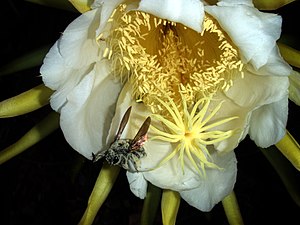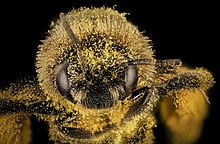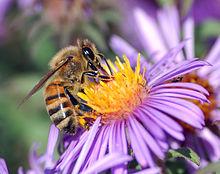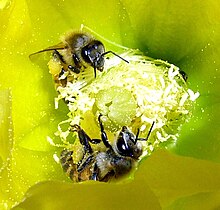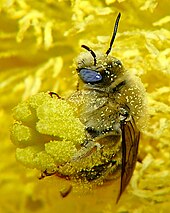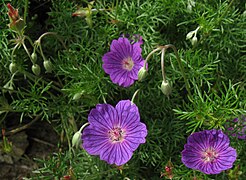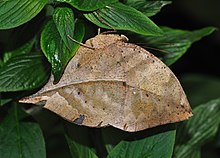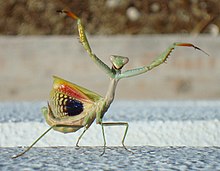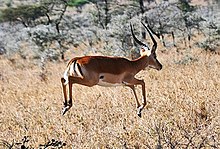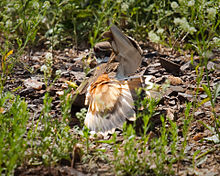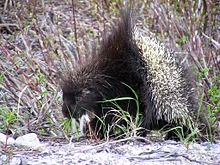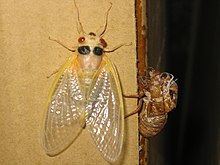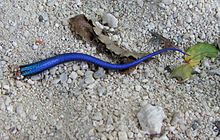Female Xylocopa with pollen collected from night-blooming cereus
Tip of a tulip stamen covered with pollen grains.
Pollination is the transfer of pollen from a male part of a plant to a female part of a plant, later enabling fertilisation and the production of seeds, most often by an animal or by wind. Pollinating agents are animals such as insects, birds, and bats; water; wind; and even plants themselves, when self-pollination
occurs within a closed flower. Pollination often occurs within a
species. When pollination occurs between species it can produce hybrid offspring in nature and in plant breeding work.
In angiosperms, after the pollen grain (gametophyte) has landed on the stigma, where it germinates and develops a pollen tube which grows down the style until it reaches an ovary. Its two gametes travel down the tube to where the gametophyte(s) containing the female gametes are held within the carpel. After entering an ovum cell through the micropyle, one male nucleus fuses with the polar bodies to produce the endosperm tissues, while the other fuses with the ovule to produce the embryo. Hence the term: "double fertilization". This process would result in the production of a seed made of both nutritious tissues and embryo.
In gymnosperms,
the ovule is not contained in a carpel, but exposed on the surface of a
dedicated support organ, such as the scale of a cone, so that the
penetration of carpel tissue is unnecessary. Details of the process vary
according to the division of gymnosperms in question. Two main modes of fertilization are found in gymnosperms. Cycads and Ginkgo have motile sperm that swim directly to the egg inside the ovule, whereas conifers and gnetophytes have sperm that are unable to swim but are conveyed to the egg along a pollen tube.
The study of pollination brings together many disciplines, such as botany, horticulture, entomology, and ecology. The pollination process as an interaction between flower and pollen vector was first addressed in the 18th century by Christian Konrad Sprengel. It is important in horticulture and agriculture, because fruiting is dependent on fertilization: the result of pollination. The study of pollination by insects is known as anthecology.
Process
Pollen germination
has three stages; hydration, activation and pollen tube emergence. The
pollen grain is severely dehydrated so that its mass is reduced enabling
it to be more easily transported from flower to flower. Germination
only takes place after rehydration, ensuring that premature germination
does not take place in the anther. Hydration allows the plasma membrane
of the pollen grain to reform into its normal bilayer organization
providing an effective osmotic membrane. Activation involves the
development of actin
filaments throughout the cytoplasm of the cell, which eventually become
concentrated at the point from which the pollen tube will emerge.
Hydration and activation continue as the pollen tube begins to grow.
In conifers, the reproductive structures are borne on cones. The
cones are either pollen cones (male) or ovulate cones (female), but some
species are monoecious and others dioecious.
A pollen cone contains hundreds of microsporangia carried on (or borne
on) reproductive structures called sporophylls. Spore mother cells in
the microsporangia divide by meiosis
to form haploid microspores that develop further by two mitotic
divisions into immature male gametophytes (pollen grains). The four
resulting cells consist of a large tube cell that forms the pollen tube,
a generative cell that will produce two sperm by mitosis, and two
prothallial cells that degenerate. These cells comprise a very reduced microgametophyte, that is contained within the resistant wall of the pollen grain.
The pollen grains are dispersed by the wind to the female,
ovulate cone that is made up of many overlapping scales (sporophylls,
and thus megasporophylls), each protecting two ovules, each of which
consists of a megasporangium (the nucellus) wrapped in two layers of
tissue, the integument and the cupule, that were derived from highly
modified branches of ancestral gymnosperms. When a pollen grain lands
close enough to the tip of an ovule, it is drawn in through the
micropyle ( a pore in the integuments covering the tip of the ovule)
often by means of a drop of liquid known as a pollination drop. The
pollen enters a pollen chamber close to the nucellus, and there it may
wait for a year before it germinates and forms a pollen tube that grows
through the wall of the megasporangium (=nucellus) where fertilisation
takes place. During this time, the megaspore mother cell divides by
meiosis to form four haploid cells, three of which degenerate. The
surviving one develops as a megaspore and divides repeatedly to form an
immature female gametophyte (egg sac). Two or three archegonia
containing an egg then develop inside the gametophyte. Meanwhile, in
the spring of the second year two sperm cells are produced by mitosis of
the body cell of the male gametophyte. The pollen tube elongates and
pierces and grows through the megasporangium wall and delivers the sperm
cells to the female gametophyte inside. Fertilisation takes place when
the nucleus of one of the sperm cells enters the egg cell in the
megagametophyte's archegonium.
In flowering plants, the anthers of the flower produce
microspores by meiosis. These undergo mitosis to form male gametophytes,
each of which contains two haploid cells. Meanwhile, the ovules produce
megaspores by meiosis, further division of these form the female
gametophytes, which are very strongly reduced, each consisting only of a
few cells, one of which is the egg. When a pollen grain adheres to the
stigma of a carpel it germinates, developing a pollen tube that grows
through the tissues of the style, entering the ovule through the
micropyle. When the tube reaches the egg sac, two sperm cells pass
through it into the female gametophyte and fertilisation takes place.
Methods
Pollination may be biotic or abiotic. Biotic pollination relies on living pollinators to move the pollen from one flower to another. Abiotic pollination relies on wind, water or even rain. About 80% of angiosperms rely on biotic pollination.
Abiotic
Abiotic pollination uses nonliving methods such as wind and water to move pollen from one flower to another. This allows the plant to spend energy directly on pollen rather than on attracting pollinators with flowers and nectar.
By wind
Some 98% of abiotic pollination is anemophily,
pollination by wind. This probably arose from insect pollination, most
likely due to changes in the environment or the availability of
pollinators.
The transfer of pollen is more efficient than previously thought; wind
pollinated plants have developed to have specific heights, in addition
to specific floral, stamen and stigma positions that promote effective pollen dispersal and transfer.
By water
Pollination by water, hydrophily,
uses water to transport pollen, sometimes as whole anthers; these can
travel across the surface of the water to carry dry pollen from one
flower to another. In Vallisneria spiralis,
an unopened male flower floats to the surface of the water, and, upon
reaching the surface, opens up and the fertile anthers project forward.
The female flower, also floating, has its stigma protected from the
water, while its sepals are slightly depressed into the water, allowing the male flowers to tumble in.
By rain
Rain
pollination is used by a small percentage of plants. Heavy rain
discourages insect pollination and damages unprotected flowers, but can
itself disperse pollen of suitably adapted plants, such as Ranunculus flammula, Narthecium ossifragum, and Caltha palustris. In these plants, excess rain drains allowing the floating pollen to come in contact with the stigma.
In rain pollination in orchids, the rain allows for the anther cap to
be removed, allowing for the pollen to be exposed. After exposure,
raindrops causes the pollen to be shot upward, when the stipe pulls them
back, and then fall into the cavity of the stigma. Thus, for the orchid
Acampe rigida, this allows the plant to self-pollinate, which is useful when biotic pollinators in the environment have decreased.
Switching methods
It is possible for a plant have varying pollination methods, including both biotic and abiotic pollination. The orchid Oeceoclades maculata uses both rain and butterflies, depending on its environmental conditions.
Melissodes desponsus covered in pollen
Biotic
Hummingbirds typically feed on red flowers
More commonly, pollination involves pollinators (also called pollen vectors): organisms that carry or move the pollen grains from the anther of one flower to the receptive part of the carpel or pistil (stigma) of another. Between 100,000 and 200,000 species of animal act as pollinators of the world's 250,000 species of flowering plant. The majority of these pollinators are insects,
but about 1,500 species of birds and mammals visit flowers and may
transfer pollen between them. Besides birds and bats which are the most
frequent visitors, these include monkeys, lemurs, squirrels, rodents and
possums.
Entomophily, pollination by insects, often occurs on plants that have developed colored petals and a strong scent to attract insects such as, bees, wasps and occasionally ants (Hymenoptera), beetles (Coleoptera), moths and butterflies (Lepidoptera), and flies (Diptera). The existence of insect pollination dates back to the dinosaur era.
In zoophily, pollination is performed by vertebrates such as birds and bats, particularly, hummingbirds, sunbirds, spiderhunters, honeyeaters, and fruit bats. Ornithophily or bird pollination is the pollination of flowering plants by birds. Chiropterophily
or bat pollination is the pollination of flowering plants by bats.
Plants adapted to use bats or moths as pollinators typically have white
petals, strong scent and flower at night, whereas plants that use birds as pollinators tend to produce copious nectar and have red petals.
Insect pollinators such as honey bees (Apis spp.),
bumblebees (Bombus spp.), and butterflies (e.g., Thymelicus flavus) have been observed to engage in flower constancy, which means they are more likely to transfer pollen to other conspecific plants.
This can be beneficial for the pollinators, as flower constancy
prevents the loss of pollen during interspecific flights and pollinators
from clogging stigmas with pollen of other flower species. It also
improves the probability that the pollinator will find productive
flowers easily accessible and recognisable by familiar clues.
Some flowers have specialized mechanisms to trap pollinators to increase effectiveness. Other flowers will attract pollinators by odor. For example, bee species such as Euglossa cordata
are attracted to orchids this way, and it has been suggested that the
bees will become intoxicated during these visits to the orchid flowers,
which last up to 90 minutes.
However, in general, plants that rely on pollen vectors tend to be
adapted to their particular type of vector, for example day-pollinated
species tend to be brightly coloured, but if they are pollinated largely
by birds or specialist mammals, they tend to be larger and have larger
nectar rewards than species that are strictly insect-pollinated. They
also tend to spread their rewards over longer periods, having long
flowering seasons; their specialist pollinators would be likely to
starve if the pollination season were too short.
As for the types of pollinators, reptile pollinators are known,
but they form a minority in most ecological situations. They are most
frequent and most ecologically significant in island systems, where
insect and sometimes also bird populations may be unstable and less
species-rich. Adaptation to a lack of animal food and of predation
pressure, might therefore favour reptiles becoming more herbivorous and
more inclined to feed on pollen and nectar.
Most species of lizards in the families that seem to be significant in
pollination seem to carry pollen only incidentally, especially the
larger species such as Varanidae and Iguanidae, but especially several species of the Gekkonidae are active pollinators, and so is at least one species of the Lacertidae, Podarcis lilfordi, which pollinates various species, but in particular is the major pollinator of Euphorbia dendroides on various Mediterranean islands.
Mammals are not generally thought of as pollinators, but some
rodents, bats and marsupials are significant pollinators and some even
specialise in such activities. In South Africa certain species of Protea (in particular Protea humiflora, P. amplexicaulis, P. subulifolia, P. decurrens and P. cordata) are adapted to pollination by rodents (particularly Cape Spiny Mouse, Acomys subspinosus) and elephant shrews (Elephantulus species). The flowers are borne near the ground, are yeasty smelling, not colourful, and sunbirds reject the nectar with its high xylose content. The mice apparently can digest the xylose and they eat large quantities of the pollen. In Australia pollination by flying, gliding and earthbound mammals has been demonstrated.
Examples of pollen vectors include many species of wasps, that
transport pollen of many plant species, being potential or even
efficient pollinators.
Mechanism
A European honey bee collects nectar, while pollen collects on its body.
Africanized honey bees immersed in Opuntia engelmannii cactus Pollen
Pollination can be accomplished by cross-pollination or by self-pollination:
- Cross-pollination, also called allogamy, occurs when pollen is delivered from the stamen of one flower to the stigma of a flower on another plant of the same species. Plants adapted for cross-pollination have several mechanisms to prevent self-pollination; the reproductive organs may be arranged in such a way that self-fertilisation is unlikely, or the stamens and carpels may mature at different times.
- Self-pollination occurs when pollen from one flower pollinates the same flower or other flowers of the same individual. It is thought to have evolved under conditions when pollinators were not reliable vectors for pollen transport, and is most often seen in short-lived annual species and plants that colonize new locations. Self-pollination may include autogamy, where pollen is transferred to the female part of the same flower; or geitonogamy, when pollen is transferred to another flower on the same plant. Plants adapted to self-fertilize often have similar stamen and carpel lengths. Plants that can pollinate themselves and produce viable offspring are called self-fertile. Plants that cannot fertilize themselves are called self-sterile, a condition which mandates cross-pollination for the production of offspring.
- Cleistogamy: is self-pollination that occurs before the flower opens. The pollen is released from the anther within the flower or the pollen on the anther grows a tube down the style to the ovules. It is a type of sexual breeding, in contrast to asexual systems such as apomixis. Some cleistogamous flowers never open, in contrast to chasmogamous flowers that open and are then pollinated. Cleistogamous flowers are by necessity found on self-compatible or self-fertile plants. Although certain orchids and grasses are entirely cleistogamous, other plants resort to this strategy under adverse conditions. Often there may be a mixture of both cleistogamous and chasmogamous flowers, sometimes on different parts of the plant and sometimes in mixed inflorescences. The ground bean produces cleistogamous flowers below ground, and mixed cleistogamous and chasmogamous flowers above.
An estimated 48.7% of plant species are either dioecious or self-incompatible obligate out-crossers. It is also estimated that about 42% of flowering plants have a mixed mating system in nature.
In the most common kind of mixed mating system, individual plants
produce a single type of flower and fruits may contain self-pollinated,
out-crossed or a mixture of progeny types.
Pollination also requires consideration of pollenizers, the plants that serve as the pollen source for other plants. Some plants are self-compatible (self-fertile) and can pollinate and fertilize themselves. Other plants have chemical or physical barriers to self-pollination.
In agriculture and horticulture
pollination management, a good pollenizer is a plant that provides
compatible, viable and plentiful pollen and blooms at the same time as
the plant that is to be pollinated or has pollen that can be stored and
used when needed to pollinate the desired flowers. Hybridization is effective pollination between flowers of different species, or between different breeding lines or populations. see also Heterosis.
Peaches
are considered self-fertile because a commercial crop can be produced
without cross-pollination, though cross-pollination usually gives a
better crop. Apples are considered self-incompatible, because a commercial crop must be cross-pollinated. Many commercial fruit tree varieties are grafted clones, genetically
identical. An orchard block of apples of one variety is genetically a
single plant. Many growers now consider this a mistake. One means of
correcting this mistake is to graft a limb of an appropriate pollenizer
(generally a variety of crabapple) every six trees or so.
The wasp Mischocyttarus rotundicollis transporting pollen grains of Schinus terebinthifolius
Coevolution
Melittosphex burmensis, the oldest bee fossil, from the Cretaceous
The first fossil record for abiotic pollination is from fern-like plants in the late Carboniferous period. Gymnosperms show evidence for biotic pollination as early as the Triassic
period. Many fossilized pollen grains show characteristics similar to
the biotically dispersed pollen today. Furthermore, the gut contents,
wing structures, and mouthpart morphology of fossilized beetles and flies suggest that they acted as early pollinators. The association between beetles and angiosperms during the early Cretaceous
period led to parallel radiations of angiosperms and insects into the
late Cretaceous. The evolution of nectaries in late Cretaceous flowers
signals the beginning of the mutualism between hymenopterans and angiosperms.
Bees provide a good example of the mutualism that exists between hymenopterans
and angiosperms. Flowers provide bees with nectar (an energy source)
and pollen (a source of protein). When bees go from flower to flower
collecting pollen they are also depositing pollen grains onto the
flowers, thus pollinating them. While pollen and nectar, in most cases,
are the most notable reward attained from flowers, bees also visit
flowers for other resources such as oil, fragrance, resin and even
waxes. It has been estimated that bees originated with the origin or diversification of angiosperms. In addition, cases of coevolution
between bee species and flowering plants have been illustrated by
specialized adaptations. For example, long legs are selected for in Rediviva neliana, a bee that collects oil from Diascia capsularis,
which have long spur lengths that are selected for in order to deposit
pollen on the oil-collecting bee, which in turn selects for even longer
legs in R. neliana and again longer spur length in D. capsularis is selected for, thus, continually driving each other's evolution.
In agriculture
Bombus ignitus, a popular commercial pollinator in Japan and China
The most essential staple food crops on the planet, like wheat, maize, rice, soybeans and sorghum
are wind pollinated or self pollinating. When considering the top 15
crops contributing to the human diet globally in 2013, slightly over 10%
of the total human diet of plant crops (211 out of 1916
kcal/person/day) is dependent upon insect pollination.
Pollination management
is a branch of agriculture that seeks to protect and enhance present
pollinators and often involves the culture and addition of pollinators
in monoculture situations, such as commercial fruit orchards. The largest managed pollination event in the world is in Californian almond orchards, where nearly half (about one million hives) of the US honey bees are trucked to the almond orchards each spring. New York's apple crop requires about 30,000 hives; Maine's blueberry
crop uses about 50,000 hives each year. The US solution to the
pollinator shortage, so far, has been for commercial beekeepers to
become pollination contractors and to migrate. Just as the combine harvesters follow the wheat harvest from Texas to Manitoba, beekeepers follow the bloom from south to north, to provide pollination for many different crops.
In America, bees are brought to commercial plantings of cucumbers, squash, melons, strawberries, and many other crops. Honey bees are not the only managed pollinators: a few other species of bees are also raised as pollinators. The alfalfa leafcutter bee is an important pollinator for alfalfa seed in western United States and Canada. Bumblebees are increasingly raised and used extensively for greenhouse tomatoes and other crops.
The ecological and financial importance of natural pollination by insects to agricultural crops,
improving their quality and quantity, becomes more and more appreciated
and has given rise to new financial opportunities. The vicinity of a forest or wild grasslands with native pollinators near agricultural crops, such as apples, almonds or coffee
can improve their yield by about 20%. The benefits of native
pollinators may result in forest owners demanding payment for their
contribution in the improved crop results – a simple example of the
economic value of ecological services. Farmers can also raise native
crops in order to promote native bee pollinator species as shown with L. vierecki in Delaware and L. leucozonium in southwest Virginia.
The American Institute of Biological Sciences reports that native insect pollination saves the United States agricultural economy nearly an estimated $3.1 billion annually through natural crop production; pollination produces some $40 billion worth of products annually in the United States alone.
Pollination of food crops has become an environmental issue, due to two trends. The trend to monoculture means that greater concentrations of pollinators are needed at bloom time than ever before, yet the area is forage poor or even deadly to bees for the rest of the season. The other trend is the decline of pollinator populations, due to pesticide misuse and overuse, new diseases and parasites of bees, clearcut logging, decline of beekeeping, suburban development, removal of hedges and other habitat from farms, and public concern about bees. Widespread aerial spraying for mosquitoes due to West Nile fears is causing an acceleration of the loss of pollinators.
In some situations, farmers or horticulturists may aim to
restrict natural pollination to only permit breeding with the preferred
individuals plants. This may be achieved through the use of pollination bags.
Improving pollination in areas with suboptimal bee densities
In
some instances growers’ demand for beehives far exceeds the available
supply. The number of managed beehives in the US has steadily declined
from close to 6 million after WWII, to less than 2.5 million today. In
contrast, the area dedicated to growing bee-pollinated crops has grown
over 300% in the same time period. Additionally, in the past five years
there has been a decline in winter managed beehives, which has reached
an unprecedented rate of colony losses at near 30%.
At present, there is an enormous demand for beehive rentals that cannot
always be met. There is a clear need across the agricultural industry
for a management tool to draw pollinators into cultivations and
encourage them to preferentially visit and pollinate the flowering crop.
By attracting pollinators like honey bees and increasing their foraging
behavior, particularly in the center of large plots, we can increase
grower returns and optimize yield from their plantings. ISCA
Technologies,
from Riverside California, created a semiochemical formulation called
SPLAT Bloom, that modifies the behavior of honey bees, inciting them to
visit flowers in every portion of the field.
Environmental impacts
Loss of pollinators, also known as Pollinator decline (of which colony collapse disorder
is perhaps the most well known) has been noticed in recent years. These
loss of pollinators have caused a disturbance in early plant
regeneration processes such as seed dispersal and pollination. Early
processes of plant regeneration greatly depend on plant-animal
interactions and because these interactions are interrupted,
biodiversity and ecosystem functioning are threatened.
Pollination by animals aids in the genetic variability and diversity
within plants because it allows for out-crossing instead for
self-crossing. Without this genetic diversity there would be a lack of
traits for natural selection to act on for the survival of the plant
species. Seed dispersal
is also important for plant fitness because it allows plants the
ability to expand their populations. More than that, it permits plants
to escape environments that have changed and have become difficult to
reside in. All of these factors show the importance of pollinators for
plants, which are the a significant part of the foundation for a stable
ecosystem. If only a few species of plants depended on Loss of
pollinators is especially devastating because there are so many plant
species rely on them. More than 87.5% of angiosperms, over 75% of tropical tree species, and 30-40% of tree species in temperate regions depend on pollination and seed dispersal.
Factors that contribute to pollinator decline include habitat destruction, pesticide, parasitism/diseases, and climate change.
The more destructive forms of human disturbances are land use changes
such as fragmentation, selective logging, and the conversion to
secondary forest habitat. Defaunation of frugivores is also an important driver. These alterations are especially harmful due to the sensitivity of the pollination process of plants.
Research on tropical palms found that defaunation has caused a decline
in seed dispersal, which causes a decrease in genetic variability in
this species.
Habitat destruction such as fragmentation and selective logging remove
areas that are most optimal for the different types of pollinators,
which removes pollinators food resources, nesting sites, and leads to
isolation of populations.
The effect of pesticides on pollinators has been debated because it is
difficult to determine that a single pesticide is the cause as opposed
to a mixture or other threats. Whether exposure alone causes damages, or if the duration and potency are also factors is unknown. However, insecticides have negative effects, as in the case of neonicotinoids
that harm bee colonies. Many researchers believe it is the synergistic
effects of these factors which are ultimately detrimental to pollinator
populations.
Examples of affected pollinators
The
most known and understood pollinator, bees, have been used as the prime
example of the decline in pollinators. Bees are essential in the
pollination of agricultural crops and wild plants and are one of the
main insects that perform this task. Out of the bees species, the honey bee or Apis mellifera has been studied the most and in the United States, there has been a loss of 59% of colonies from 1947 to 2005.
The decrease in populations of the honey bee have been attributed to
pesticides, genetically modified crops, fragmentation, parasites and
diseases that have been introduced.
There has been a focus on neonicotinoids effects on honey bee
populations. Neonicotinoids insecticides have been used due to its low
mammalian toxicity, target specificity, low application rates, and broad
spectrum activity. However, the insecticides are able to make its way
throughout the plant, which includes the pollen and nectar. Due to this,
it has been shown to effect on the nervous system and colony relations
in the honey bee populations.
Butterflies
too have suffered due to these modifications. Butterflies are helpful
ecological indicators since they are sensitive to changes within the
environment like the season, altitude, and above all, human impact on
the environment. Butterfly populations were higher within the natural
forest and were lower in open land. The reason for the difference in
density is the fact that in open land the butterflies would be exposed
to desiccation and predation. These open regions are caused by habitat
destruction like logging for timber, livestock grazing, and firewood
collection. Due to this destruction, butterfly species' diversity can
decrease and it is known that there is a correlation in butterfly
diversity and plant diversity.
Food security and pollinator decline
Besides
the imbalance of the ecosystem caused by the decline in pollinators, it
may jeopardise food security. Pollination is necessary for plants to
continue their populations and 3/4 of the plant species that contribute
to the world's food supply are plants that require pollinators.
Insect pollinators, like bees, are large contributors to crop
production, over 200 billion dollars worth of crop species are
pollinated by these insects.
Pollinators are also essential because they improve crop quality and
increase genetic diversity, which is necessary in producing fruit with
nutritional value and various flavors.
Crops that do not depend on animals for pollination but on the wind or
self-pollination, like corn and potatoes, have doubled in production and
make up a large part of the human diet but do not provide the
micronutrients that are needed. The essential nutrients that are necessary in the human diet are present in plants that rely on animal pollinators.
There have been issues in vitamin and mineral deficiencies and it is
believed that if pollinator populations continue to decrease these
deficiencies will become even more prominent.
Plant–pollinator networks
Wild
pollinators often visit a large number of plant species and plants are
visited by a large number of pollinator species. All these relations
together form a network of interactions between plants and pollinators.
Surprising similarities were found in the structure of networks
consisting out of the interactions between plants and pollinators. This
structure was found to be similar in very different ecosystems on
different continents, consisting of entirely different species.
The structure of plant-pollinator networks may have large
consequences for the way in which pollinator communities respond to
increasingly harsh conditions. Mathematical models, examining the
consequences of this network structure for the stability of pollinator
communities suggest that the specific way in which plant-pollinator
networks are organized minimizes competition between pollinators and may even lead to strong indirect facilitation between pollinators when conditions are harsh.
This means that pollinator species together can survive under harsh
conditions. But it also means that pollinator species collapse
simultaneously when conditions pass a critical point. This simultaneous
collapse occurs, because pollinator species depend on each other when
surviving under difficult conditions.
Such a community-wide collapse, involving many pollinator
species, can occur suddenly when increasingly harsh conditions pass a
critical point and recovery from such a collapse might not be easy. The
improvement in conditions needed for pollinators to recover, could be
substantially larger than the improvement needed to return to conditions
at which the pollinator community collapsed.
